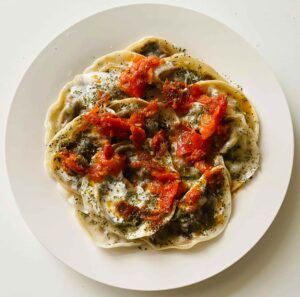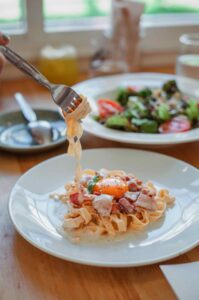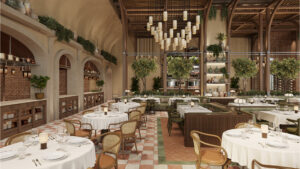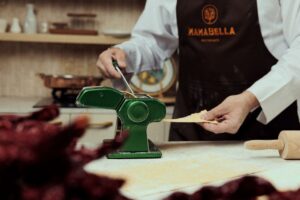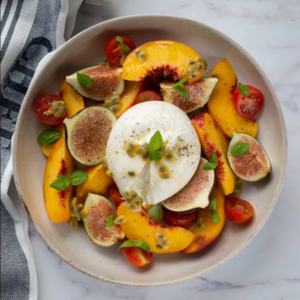At Mama Bella, we celebrate the cheeses that define Italy’s culinary soul—especially the bold, pastoral flavors of Sardinia. This beginner-friendly guide explores how iconic styles like Parmigiano-Reggiano and Pecorino transform simple ingredients into unforgettable dishes, and how these cheeses will inspire the tasting menus we’re developing in Dubai. Located within Kempinski, The Boulevard, our Italian restaurant concept honors Sardinian tradition with handcrafted pasta, wood-fired pizzas, and a family-style approach to dining. As we are in a pre-launch phase, consider this your sneak peek into the textures, flavors, and pairings that shape authentic Italian and Mediterranean cuisine.
Key takeaways
- Italian cheeses range from soft and milky to firm and granular; Parmesan (Parmigiano-Reggiano) and Pecorino are essential for classic flavor and texture.
- Pair nutty, crystalline Parmigiano with fresh fruit or honey; match savory, salty Pecorino with cured meats and robust wines.
- Sardinian specialties—especially Pecorino Sardo and Fiore Sardo—anchor our focus on Sardinian cuisine in Dubai and inspire our handcrafted pasta and wood-fired pizza concepts.
What is Italian cheese?
Italian cheese is a living expression of regional landscapes, animal breeds, and centuries of craft. From the lush plains supplying rich cow’s milk to the rugged Sardinian hills where sheep graze on wild herbs, each cheese captures a place and a season. For guests exploring Italian cheese for the first time, start with four foundational styles you’ll encounter often at an Italian restaurant in Dubai: mozzarella, Parmigiano-Reggiano, Gorgonzola, and ricotta. Together they demonstrate how milk, time, and technique can create wildly different results.
Overview of popular Italian varieties
- Mozzarella: Soft, elastic, and delicately lactic. Fresh mozzarella shines on a Caprese with ripe tomatoes and basil, and it melts beautifully on wood-fired pizza.
- Parmigiano-Reggiano: Hard and naturally granular with a deep nutty aroma. Grate it over pasta or shave it onto salads for umami and texture.
- Gorgonzola: A blue cheese ranging from creamy and mild to bold and piquant. It enriches sauces for gnocchi and risotto.
- Ricotta: Light, fresh, and slightly grainy. Essential for lasagne layers, stuffed pastas, and desserts.
These cheeses don’t just add flavor; they provide structure—stretch, creaminess, or savory depth—so that simple dishes feel refined and complete.
Why is Parmigiano-Reggiano renowned?
Parmigiano-Reggiano is called the “King of Cheeses” for good reason. Its complex, savory profile comes from exceptional milk, careful curd handling, brining, and long aging. As it matures, moisture recedes and protein networks form the tiny crystals that create a satisfying, slightly crumbly bite. Even a small shaving can elevate vegetables, pasta, and soups.
Production and aging in brief
Producers start with high-quality cow’s milk, add natural rennet, and gently heat and cut the curd. After shaping and brining, wheels age for a minimum of 12 months—often much longer—while affineurs manage temperature and humidity to coax out aroma and texture. Older wheels (24–36 months) taste nuttier and more intense, perfect for grating or pairing with fruit. Younger wheels can feel slightly creamier with a milder finish.
What makes Pecorino unique?
Pecorino is the sheep’s-milk counterpart to Italy’s famous hard cheeses—brighter, saltier, and wonderfully savory. Because sheep’s milk is richer in fat and protein than cow’s milk, Pecorino develops a distinctive, mouth-filling character that stands up to pepper, cured meats, and robust wines.
Romano vs. Sardo: two beloved styles
Pecorino Romano is assertive and salty, ideal for grating over spaghetti alla carbonara or cacio e pepe. Pecorino Sardo, made in Sardinia, tends to be more rounded and aromatic; young versions are springy and pleasantly tangy, while aged wheels become firmer and deeply savory. For a Sardinian-inspired cheese board, Pecorino Sardo pairs beautifully with honey, walnuts, and pears.
How to pair Italian cheeses with food
Pairing is about balance: match intensity with intensity and contrast richness with freshness. If you’re planning dinner in Dubai with an Italian theme, these combinations are crowd-pleasers and easy to replicate at home.
Parmigiano-Reggiano pairings
- Fruit & sweetness: Fresh figs, crisp apples, or a drizzle of acacia honey highlight Parmigiano’s nutty sweetness.
- Vegetables: Shave over grilled asparagus or roasted pumpkin to add umami and texture.
- Wine: Sparkling wine or a crisp white balances the cheese’s savory edge.
Pecorino pairings
- Cured meats: Prosciutto and bresaola (or similar cured meats) complement Pecorino’s savory bite.
- Pasta classics: Use Pecorino as the star in pepper-forward sauces and simple emulsions.
- Wine: Medium to full-bodied reds, like a Sangiovese blend, stand up to Pecorino’s intensity.
When building a cheese platter, mix milk types (cow, sheep, and goat), add seasonal fruit, nuts, olives, and a sweet element like honey or fig jam. Offer both crusty bread and thin crackers to showcase texture without overwhelming flavor.
Sardinian cheese traditions to know
Sardinia’s landscape—windswept coasts, herb-rich hills, and small shepherding communities—has shaped cheeses with personality and depth. For our Sardinian cuisine in Dubai, we look to styles that express this heritage.
Essential Sardinian styles
- Pecorino Sardo: The island’s signature cheese, ranging from young and supple to aged and robust. Excellent for grating, shaving, or serving as table cheese.
- Fiore Sardo: Traditionally smoked, with a firm texture and nutty, slightly toasty notes—beautiful against honey and roasted vegetables.
These cheeses are pillars of Sardinian cooking and inform the flavors we plan to highlight at Mama Bella through handcrafted pasta, wood-fired pizza toppings, and shareable antipasti.
Italian cheese in cooking: recipes and tips
In our menu development for Dubai, cheese is never an afterthought—it’s a building block. Here are practical ways to use Italian cheese in home cooking, mirroring the techniques we value.
Pasta foundations
For a weeknight pasta, reserve some starchy cooking water. Toss al dente strands with butter or extra virgin olive oil, then add finely grated Parmigiano-Reggiano to create a silky emulsion. For a Sardinian accent, finish with Pecorino Sardo and cracked black pepper. In layered dishes like lasagne, combine ricotta for lightness, mozzarella for melt, and Parmigiano for a savory, burnished top.
Wood-fired pizza logic (at home)
Neapolitan-style mozzarella melts quickly and stretches; aged cheeses like Parmigiano contribute a flavorful crust when sprinkled after baking. Try a white pizza: mozzarella base, dollops of ricotta, sautéed mushrooms, and a final snowfall of Parmigiano. A few curls of Pecorino add a savory snap that keeps each bite lively.
Smart storage and serving
- Buy wedges instead of pre-grated cheese and grate to order for the best aroma.
- Wrap hard cheeses in breathable paper and keep them in the fridge’s cheese drawer or a covered box.
- Bring cheese to room temperature before serving to unlock aroma and texture.
Dining at Mama Bella (pre-launch preview)
Mama Bella will bring a refined yet welcoming Sardinian experience to Kempinski, The Boulevard in Dubai. Expect handcrafted pasta made fresh daily, wood-fired cooking, and a Mediterranean approach to simplicity—letting excellent ingredients speak for themselves. Because we’re in a pre-launch phase, final menus and offerings are under development, but our team is crafting dishes that showcase Pecorino Sardo, Fiore Sardo, and thoughtfully selected Italian cheeses in a family-style setting.
Ambiance and approach
Our design channels rustic Sardinian charm—uncovered wooden beams, natural textures, and sun-lit spaces—balanced with the elegance you expect in a Kempinski restaurant in Dubai. Meals are meant for sharing: large platters of pasta, thoughtfully topped pizzas, and antipasti that invite conversation. Whether you’re planning brunch in Dubai with friends or a relaxed dinner, our goal is to make every table feel like a celebration.
How to keep learning (and tasting)
Want to go deeper? Visit a specialty cheese counter and ask to try young versus aged versions of the same style—Pecorino Sardo dolce compared to maturo, for example. Taste side-by-side with honey, fruit, and nuts to feel how the pairings shift the experience. Our team will also share seasonal updates and Italian food insights on our blog as we approach launch in Dubai.
For those eager to experience authentic Sardinian and Italian flavors, explore our concept further, discover the menu direction we’re shaping, or plan your next family gathering with us using the links below.
Italian restaurant in Dubai insights and updates
Explore our evolving menu concepts and cheese-forward dishes
Learn about our Sardinian roots on the About us page
Bookmark our blog for tips on cheese, pasta, and Mediterranean cooking
When you’re ready, you can book a table as we near opening
Frequently asked questions
What is the purpose of this guide?
“A Beginner’s Guide to Italian Cheese: From Parmigiano to Pecorino” helps newcomers understand core Italian cheeses—what they taste like, how to use them, and how they fit into Sardinian cuisine in Dubai. It’s an approachable starting point for confident, delicious cooking.
Which cheeses should I try first?
Start with mozzarella for melt and freshness, Parmigiano-Reggiano for savory depth, Gorgonzola for creamy tang, and Pecorino (especially Pecorino Sardo) for bold, sheep’s-milk character. As your palate grows, add Fiore Sardo for smoky nuance.
How do I use these cheeses in everyday cooking?
Grate Parmigiano into emulsified pasta sauces, melt mozzarella on pizzas and baked dishes, stir Gorgonzola into cream for gnocchi, and shave Pecorino over vegetables or hearty salads. Balance richness with acidity (lemon, tomatoes) and a touch of sweetness (honey, pears).
Is the menu finalized?
Not yet. Mama Bella is in a pre-launch phase at Kempinski, The Boulevard in Dubai. Our culinary team is actively developing a menu that showcases Sardinian traditions—especially Pecorino Sardo and Fiore Sardo—alongside handcrafted pasta and wood-fired pizza.
Where can I find out more or plan a visit?
For the latest updates on Sardinian cuisine in Dubai and to plan your experience, explore our Sardinian restaurant Dubai page, browse the menu outlines, and keep an eye on our reservations page as we approach opening.


